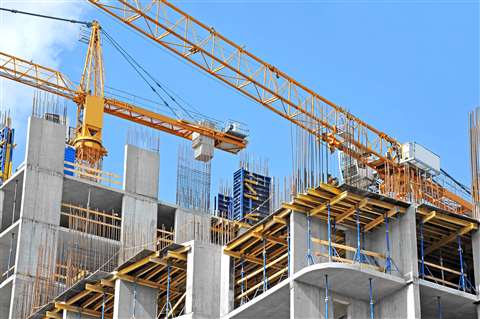The supply chain reaction
March 22, 2022
Supply chain disruptions are hitting hard in Europe and the conflict in Ukraine means companies will need to be resilient to weather another year of uncertainty. Catrin Jones reports.
Across the globe, ongoing supply chain issues and operational disruptions are the main concern, according to sector professionals who responded to the Allianz Risk Barometer 2022. It was reported last year that surges in demand were accompanied by disruptions in production and logistics when factories were forced to close following Covid-19 outbreaks.
“The industry is facing a large number of challenges – at the top of which are supply chain bottlenecks and shortages of materials and staff,” says Jonathan Tabor, head of construction and IDI, regional unit London and Nordics, at AGCS.
Loss of output across the wider Eurozone
Global supply chains, in recent years, have faced an unprecedented level of pressure. Continually rising prices, disruption to shipping and ports, material shortages, and Russia’s invasion of Ukraine only puts further strain on global supply chains’ ability to recover.
 The construction sector faces more challenges due to conflict in the East (Photo: Unsplash - Christopher Burns)
The construction sector faces more challenges due to conflict in the East (Photo: Unsplash - Christopher Burns)
The Achilles Supply Chain Resilience Index (ASCRI) 2021 Q4 report stated that supply chain resilience further decreased in the final quarter of last year. Deteriorations were a result of Covid-19 concerns on the Omicron variant, a shift in purchasing behaviours, and ongoing logistical challenges.
It was predicted that ongoing commodity prices would continue to put stress on supply chains into 2022. Uncertainty over the Russia-Ukraine conflict was also a notable concern with apprehension over commodity prices further increasing.
“The Russia-Ukraine conflict will accelerate the fracturing of global supply chains for construction which have already been severely tested by the global Coronavirus Pandemic,” says Graham Robinson, Global Infrastructure and Construction Lead at Oxford Economics.
“A prolonged Russia-Ukraine conflict will put rocket boosters under inflation for construction materials across Europe and cause a significant loss of investor confidence and a loss of output across the wider Eurozone but concentrated in Eastern European countries.”
The escalating conflict appears to be one of Europe’s biggest risks. Prices have already started to respond accordingly and there are fears that there will be further price increases and shortages, both direct and indirect. The conflict will likely continue to drive decisions made throughout the supply chain across Europe.
Despite this, lumber shortages have been easing in Europe – the price of imported sawn or planed wood has since fallen by 9.3% since December.
The timber market has demonstrated increasing stability but with the EU-imposed sanctions on Belarus and the expectation that this will be matched for Russia, the industry is likely to suffer from tighter supply and shortages in some areas.
David Hopkins, CEO of Timber Development UK, advised members to cease trading with Russia and Belarus. In doing so, Hopkins recognises that this will disrupt timber supplies into Europe and to the UK market with Russia and Belarus accounting for around 10% of the softwood market in the continent.
Weathering the crisis
Katie Tamblin, chief product officer at Achilles and author of the ASCRI report, said, “Supply chain data emerging from Q4 2021 was already indicating that 2022 would be a rocky road for global supply chains, and now with the additional conflict in Ukraine, the outlook is extremely concerning.
“Pummelled by so many challenges over the last two years, supply chains have not had time to recover, and we now face a critical tipping point that could have both supply and cost ramifications rippling through industrial and consumer markets for years to come.”
Tamblin added, “Our data shows that to weather this crisis, organisations need visibility across their supply chains to identify vulnerabilities and alternative sources of supply.”
Russia remains a key player in many companies’ supply chains, yet those who can afford to do so, have opted to boycott the European giant. Due to the current supply chain disruption and uncertainty, both financially and economically, Komatsu is one of a number of construction equipment manufacturers making early statements about ceasing shipments to Russia for the time being.
Making decisions to cease shipment to Russia and having to resource materials from alternative suppliers is not a decision made lightly and thus puts pressure on other streams.
“The construction market could be overheating,” says Ian Cooper, director and head of the construction sector at legal and business services provider DWF.
He adds, “The continued growth in activity, across all sectors, is putting a significant demand on the available supply chain to deliver. Whilst it is good news to see input cost inflation ease, the industry is very busy with contractor’s order books full for at least the year ahead.”
Commenting on the IHS Markit/CIPS UK Construction PMI for February 2022, Cooper says, “Consequently, it is no surprise that buying has increased as clients look to secure increasingly scarce construction delivery resources.”
Improving resilience
A survey by McKinsey, made up of senior supply-chain executives, reported that 93% of respondents intended to address the function of their supply chains – this would be done through a planned increase in inventory of critical products and the dual sourcing of raw materials.
Supply-chain planning wins have been attributed to the adoption of modern digital tools and using advanced technology. The survey stated that 75% of the construction sector had some analytics implemented in the past year, with more planned, but the sector is less than enthusiastic about further investment in digital supply chain technologies in the future.
Despite 2021 being a challenging year for most in the construction sector, figures from the IHS Markit and the Chartered Institute of Procurement and Supply (Cips) in February have demonstrated that manufacturing growth could be improving, with some supply chain pressures showing promising signs of easing, although slowly.
While the survey did find that input price inflation remained elevated, it highlighted reports in some areas of fewer raw material shortages.
As the conflict in Ukraine continues to cast a dark shadow over Europe, and demand for construction materials continues to be extremely high, it is imperative that construction businesses continue to be vigilant and proof themselves against ongoing supply chain pressures.
Will the supply-side disruptions ease or not?
Europe’s major industry associations are constantly gathering data on supply chain issues, to disseminate to the industry.
CECE’s economic expert, Sebastian Popp, spoke of the current challenges during a recent CECE economic webinar. He said, “The immediate effect [of supply chain disruptions in 2021] was that only a fraction of the potential business did materialise.
 Commodity prices are likely to put a strain on supply chains (Photo Adobe Stock)
Commodity prices are likely to put a strain on supply chains (Photo Adobe Stock)
“When we look at the order intake of the industry, the theoretical potential would have been way higher – orders were much higher than what could be achieved because machines could not be built or be delivered in the proper way.
“This may be helpful in the medium term – it may prolong the growth trajectory, as it helps in uncertain times, like today, to have a strong order backlog.”
Prepare for the worst
Forward-thinking, inventory forecasting, and meticulous planning are advantageous for companies to plan for uncertain times and further disruption.
The France-based company, Evolis, stated in the CECE Annual Economic Report 2022 that equipment sales are slowly creeping up to the record levels reported in 2019 but the shortage of raw materials had a strong impact on the availability of equipment in the second half of 2021 which in turn slowed down invoicing.
Painful truth
CECE member, VDMA, also noted that severe supply-chain disruptions had a dampening effect on the market last year and with the supply-side not expected to ease rapidly, they will be unable to anticipate the potential for the coming year.
Popp added, “The forecast for 2022 is primarily uncertain because of the question: will the supply-side disruptions ease or not? Some manufacturers were even considering revising their forecasts downwards because they did not anticipate the availability of components improving significantly.
Overall, though, Popp did say he was optimistic that the worst of the supply-side bottlenecks were behind us.
MAGAZINE
NEWSLETTER

CONNECT WITH THE TEAM










